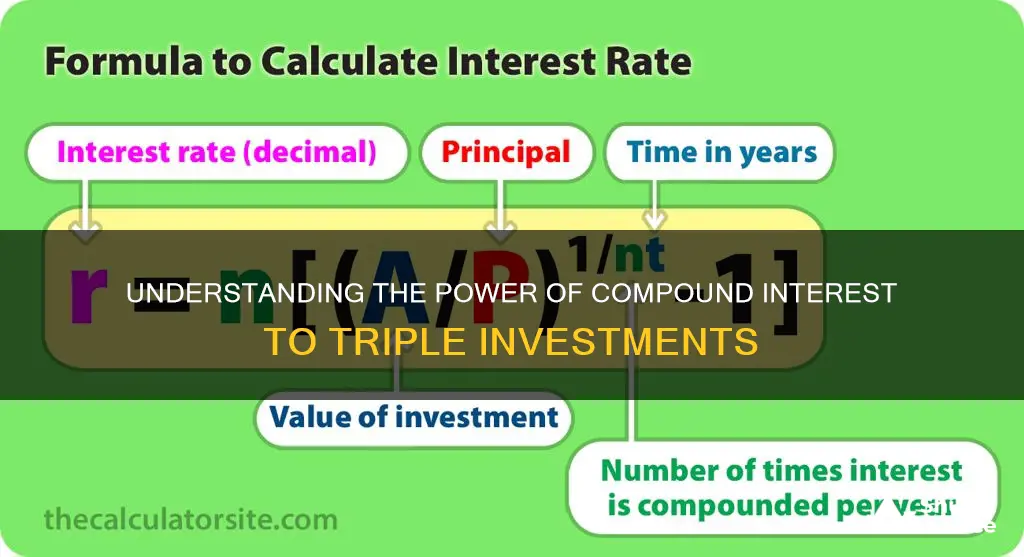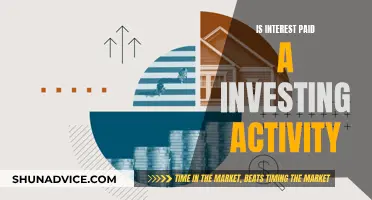
The amount of time it takes for an investment to triple depends on the interest rate. For example, if an investment has a 5% interest rate, it will take around 22 years to triple. If the interest rate is 7%, it will take approximately 16.4 years.
| Characteristics | Values |
|---|---|
| Time taken to triple an investment with 7% interest | 16.4 years |
| Time taken to triple an investment with 5% interest | 22 years |
What You'll Learn

How long it takes money to triple at 7% interest
If you have an interest rate of 7% and you want to know how long it will take for your money to triple, you can use the rule of 115. This rule is a shortcut to determine how long it takes for compounded money to triple. To use this rule, divide the interest rate into 115. Assuming a 7% interest rate, it will take approximately 16.4 years for your money to triple.
The compound interest formula is: A = Pert. Where A is the current value, P is the initial investment, r is the rate, and t is time. If an investment triples, that means A is currently equal to 3*P.
Cash in Investment Portfolios: Gaining Interest?
You may want to see also

How long it takes money to triple at 5% interest
The Rule of 72 is a quick and easy method for determining how long it will take to double the money you're investing, assuming it has a fixed annual rate of return. The Rule of 69.3 is more accurate, particularly for continuous compounding interest rate instruments. To calculate how long it takes money to double, divide the interest rate into 72. To see how long money triples, divide it into 115. Assuming a 7% interest rate, it will take approximately 10.3 years for the original principal to double and 16.4 years to triple.
If you want to calculate how long it takes money to triple at 5% interest, you can use the compound interest formula: A = Pert. Where A is the current value, P is the initial investment, r is the rate, and t is time. If an investment triples, that means A is currently equal to 3*P. So, 3P = Pe0.05*t. 3 = e0.05t. ln(3) = 0.05*t. t = ln(3)/0.05. t = ~22 years.
Compounding Interest: Annual vs. Quarterly, Which is Better?
You may want to see also

How to calculate the time it takes for an investment to triple
The time it takes for an investment to triple depends on the interest rate.
The formula for calculating compound interest is: A = Pert, where A is the current value, P is the initial investment, r is the rate, and t is time. If an investment triples, that means A is currently equal to 3*P.
For example, if you have an interest rate of 5% (or 0.05), the formula would be: 3P = Pe0.05*t. This can be simplified to: 3 = e0.05t, and then to: t = ln(3)/0.05. This means it would take approximately 22 years for the investment to triple.
There is also a rule of thumb called the rule of 115, which provides a quick way of seeing the value and speed of compounding. To calculate how long it takes money to triple, divide the interest rate into 115. For example, assuming a 7% interest rate, it will take approximately 16.4 years for the original principal to triple.
Interest Rate Strategies for Investment Growth
You may want to see also

How to calculate the current value of an investment
The current value of an investment is calculated using the compound interest formula: A = Pert. In this formula, A is the current value, P is the initial investment, r is the rate, and t is time.
If an investment triples, that means A is currently equal to 3*P. For example, if you have an initial investment of $100 and it triples, the current value is $300.
To calculate how long it will take for an investment to triple, you can use the rule of 115. This rule provides a quick way to determine the speed of compounding. To use this rule, divide the interest rate into 115. For example, if you have a 7% interest rate, it will take approximately 16.4 years for your investment to triple.
Alternatively, you can use the compound interest formula to calculate the time it takes for an investment to triple. For example, if you have an interest rate of 5% and an initial investment of $100, the formula would be: 300 = 100e0.05*t. Solving for t, you would get: t = ln(3)/0.05, which is approximately 22 years.
The Magic of Compound Interest for Long-Term Investments
You may want to see also

How to calculate the initial investment
To calculate the initial investment, you need to use the compound interest formula: A = Pert. In this formula, A is the current value, P is the initial investment, r is the rate, and t is time. If an investment triples, that means A is currently equal to 3*P.
For example, if you have a 7% interest rate, it will take approximately 10.3 years for the original principal to double and 16.4 years to triple.
If you have a 5% interest rate, you can calculate the time it takes for the investment to triple by using the following formula: 3P = Pe0.05*t. This can be simplified to 3 = e0.05t, and then to t = ln(3)/0.05. This means it will take approximately 22 years for the investment to triple.
Understanding Investment Interest Expense: What Investors Need to Know
You may want to see also
Frequently asked questions
It will take approximately 22 years for an investment to triple if interest is compounded continuously at 5%.
It will take approximately 16.4 years for an investment to triple if interest is compounded annually at 7%.
The formula for calculating how long it will take for an investment to triple is: A = Pert, where A is the current value, P is the initial investment, r is the rate, and t is time.
You can use the rule of 115 to calculate how long it will take for your investment to triple. Divide 115 by the interest rate to determine the number of years it will take for your investment to triple.







